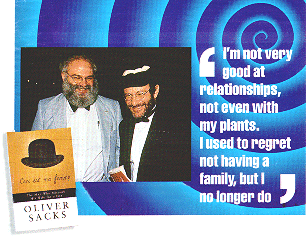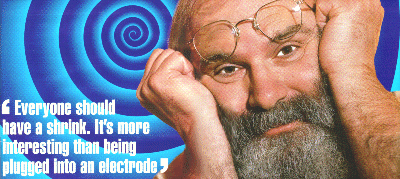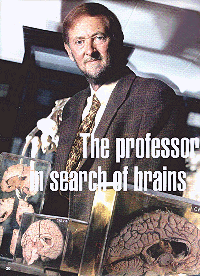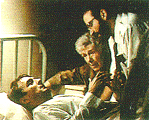The Mind Traveller
|
Migraine at the age of two and the beatings at boarding school helped
fashion the life of neurologist and bestselling author
Oliver Sacks. Now,in his TV series,he aims to unravel
the chaos that can be the human mind.
 Dr Oliver sacks is the diffident,charming, but
undoubtedly odd neurologist who thinks of himself as a reporter from the
borders of human experience and who was thrust unwillingly into fame when
Robin Williams played him in a film based on his book, Awakenings,
about how he administered L Dopa to sleeping-sickness patients and miraculously
cured them, albeit temporarily. The book was also the basis of a play by
Harold Pinter, A Kind of Alaska, while his subsequent work The
Man Who Mistook His Wife For A Hat was turned into a stage play by Peter
Brook.
Dr Oliver sacks is the diffident,charming, but
undoubtedly odd neurologist who thinks of himself as a reporter from the
borders of human experience and who was thrust unwillingly into fame when
Robin Williams played him in a film based on his book, Awakenings,
about how he administered L Dopa to sleeping-sickness patients and miraculously
cured them, albeit temporarily. The book was also the basis of a play by
Harold Pinter, A Kind of Alaska, while his subsequent work The
Man Who Mistook His Wife For A Hat was turned into a stage play by Peter
Brook.
He is instantly recognisable - burly, bearded, dressed in baggy
clothes, sandals, grey socks, and clutching a couple of carrier bags. We
are in an editing suite in London to discuss his current series, The Mind
Traveller but first he catches sight of a banana on a desk and picks
it up. "I love them. Would you like half?" He talks in a precise way with
a slightly sing-song stammer, reminiscent of the former Archbishop Runcie,
searching for the right word amid numerous "ums". His favourite is that clincher
of academic equivocation, "but" ,although he is adamant in his dislike of
the series title. "I didn't want it to refer to me. I'd prefer Neurological
Adventures, or something like that. I loved David
Attenborough's The Secret Life of Plants. That wasn't called The
Plant Traveller. These days everything comes down to personality and
it shouldn't. I want to be the conduit for my subjects. It's them, not me."
He fidgets a lot, sighs and leaves the room to wash, as he
is feeling sticky after eating the banana. when he returns he continues,
"I don't feel too comfortable in this role as a television narrator. I have
to act a bit and don't like being looked at by the camera. It might cause
an involuntary exhibitionism. I was in several minds about doing the series,
but I'd met Chris Rawlence, the director , ten years ago when he wrote the
libretto for a Channel 4 opera of The Hat, and he wanted to make a
picture of what interests a neurologist'. Things went in all directions and
we inadvertently made nine instead of six films."
His enthusiasm for his subjects people who are deaf blind,
colour blind, autistic, or with Williams' or Tourette's syndrome is warm
and overwhelming, yet he has been accused of parading a freak show of the
mentally disturbed. " Any external criticism is amplified thousand fold
internally," he says, slightly anguished. "One must be on one's guard all
the time for the propriety of the relationships. I think there is sympathy
and curiosity mixed with less noble attitudes like voyeurism for those who
are different or disabled people would crowd to see the inhabitants of Bedlam
on Sunday - but I do hope I can give a sense of lives that are interestingly
"other" and deserve respect and admiration." This week's programme, Rage
for Order, is a perfect example: the moving and sympathetically told
story of Jessy an autistic artist whose mind holds deep obsessions she can't
bear lights being left on and is fascinated by burglar alarms, cashpoint
machines, fridges and the weather channel on TV.
Dr Sacks was born in north London in 1933 to parents who were
both doctors. His interest in neurology was sparked when he was two and began
to have migraines. "I lost vision and colour. Faces became unrecognisable.
This gave me an early and frightened sense that the world is constructed
by the nervous system and can be misconstrued in
all sorts of ways." Already an inward-looking boy, his isolation
was further compounded when, at the outbreak of the Second World War, he
was sent to boarding school near , Northampton. "Pressure was put on parents
to get their children out of danger. It wasn't evident at the time that there
might be psychological problems in separation from the family but it soon
became clear. For me, it was traumatic. I think it had an effect on the rest
of my life. It was a harsh four years and the food was terrible Swedes, turnips
and mangelwurzel. I never wanted to see another mangelwurzel and I haven't.
I try to recall those days, but meet the resistance of amnesia, or whatever."
He stands and runs a hand along his bottom. I still feel sore here at the
memory of some of the beatings."
He opens the window he is oversensitive to temperature (he
calls it thermal psychosis; he is also claustrophobic and afraid of the dark)
before continuing. "The notion of the good and terrible institution has haunted
me ever since, and is one of the reasons why much of my - practice is in
institutions." He studied at Oxford, qualified as a doctor at the Middlesex
Hospital, did some unsuccessful research in Birmingham, before departing
for California in 1965 because, he says there was too much competition in
the family both his brothers were also doctors and medicine in England was
too restricted to contain "an oddity like me. I'm a restless creature" A
few years later he took up a post at the Albert Einstein
College of Medicine in New York where he is Clinical Professor of Neurology,
commuting from the Bronx in his only apparent luxury, a Mercedes.
Every day he visits the botanical gardens, and twice a week
he goes to the zoo. "I study the great apes. It's wrong to see ourselves
as creatures of culture and forget our biological origins. All sorts of
human behaviour is unintelligible unless one considers
primate behaviour. We are intelligent apes, with
the capacity to be angelic as well as demonic." He explains how multiple
sclerosis patients sometimes detect an odd movement in the palate, inner
ear and neck. "That's the fishy thing, the vestiges of our gill arches from
100 million years ago. The notion that we have a billion years of
evolution behind us is reassuring. Everything has
been tested, honed and adapted. But equally it has become clear that even
identical twins don't have identical nervous systems. Everyone is unique.
That's reassuring, too, although it may also be a lonely thought because
it may mean no one can ever fully understand or communicate with anyone else.
We may need "normal" as a medical or social word, but life can be led from
a lot of different centres. This becomes very clear in the island community
of Pingelap [a mile-long atoll in the Pacific, featured in last week's Mind
Traveller] where eight per cent of the population has no concept of colour.
They think we're distracted by it and don't pay sufficient attention to texture,
tone and shape."
As a man trying to make order out of the apparent
chaos of our mental condition, he lost his
belief in one answer - God - early on. At
the age of ten he planted two rows of radishes and suggested that if God
wanted to prove His existence He would make one row flourish and the other
wilt. Both wilted. So he puts his faith in increased neurological
knowledge, which he believes may produce new respect for individuality,
in contrast to those who believe we face a future of virtual reality and
chemical stimulation. "But," he adds, "who knows which way the future will
go?"

He had his own tussles with pharmacologically- induced "happiness"
shortly after he became famous. "The change happened with the Hat
book. It came out in a small printing, but was a bestseller overnight. Internally
I'm probably the same as ever shy, stubborn, curious and I was unlikely to
be changed by success or fame, whatever those things mean, but all that publicity
was very peculiar. I slept badly, was full of regrets and reproaches, so
I was prescribed Prozac. Almost everyone I know was on it. Fortunately or
unfortunately it made me sick, and then I started another book, which was
better than any Prozac. In fact my footnotes [which in his latest book, The
Island of the Colour Blind, take up 71 of the 293 pages] are my Prozac.
I love writing them."
When that doesn't work he has twice weekly access to his
psychiatrist, sometimes telephoning him on his car phone from out-of-the
way places like the Arizona desert. "I've seen him for 30 years, possibly
the longest analysis in history I started because I was bored, depressed,
destructive, addicted to amphetamine fixes which
Jonathan Miller [a lifelong friend with whom he
went to St Paul's school] said was a vulgar fourth-rate drug. It made me
euphoric, but next day I was in vertical descent with a feeling of folly
I told my analyst, "Nothing ever changes. Is this what life is?" Of course,
you have to distinguish between neurotic and common unhappiness. I don't
want to recommend pain, but it is part of the human predicament and a great
deepener. I want to say that one hasn't been fully and responsibly "human"
if one doesn't experience things to the full, but I am beginning to hear
a homiletic tone that doesn't belong to neurology."
Anyway , the psychiatry works. "Now I have adventure, novelty,
risk and a slight sense of responsibility I'm
privileged to have a neutral figure who listens carefully, whom I trust and
respect, who knows my darker side. He is still Dr S to me and I am Dr Sacks
to him. I know nothing about his personal life and he knows everything about
me. Ideally, everyone should have a shrink. It's much more interesting than
being plugged into an electrode. Excuse me while I stand for a minute. I
hurt my hip and it bothers me to sit." He suffers from success as a weightlifter
in his youth he held the Californian record for a lift of over 600lb.
It is difficult to ask such an eminently nice man if the study
of the mind can make neurologists as barking mad as some psychiatrists appear
to be. Is his empathy with his patients increased because he is himself a
dysfunctional human being? He thinks for a long time. "Yes and no. I'm a
lonely person, not at ease socially. I'm terrified of
crowds and
hate being in groups. I have my clinical work I'm fond of botany and I have
a passion for swimming. It' s a fairly limited life. I know certain things
are difficult for me and on the whole I no longer do them." Perhaps this
includes sex.He has never married or lived with anyone and says he's celibate.
"Did I use a word like that? It's so sanctimonious, too much like a religious
vow, but yeah, OK. On the whole I think it' s partly fear of commitment.
I'm not very good at relationships, not even with my plants. I either
water them too much or not enough and that's what
would have happened if I had had children. They would be neglected or pampered
and that would make them unstable. I used to regret not having a family,
but I no longer do."
It seems odd that a man who has made it his job to "bond" with the mentally different says he is no good at relationships. "Ummm, yes. When my mother died, many of her patients and students came to the funeral and I learned so much about the close relationships she had with them which she never had with her family. She was an absentee mother, distant, somewhat shy and formidable, yet she was none of those things with her patients. I liked her. If anything, the relationship was too close. But these things are always so complex and ambivalent. Now she has been dead many years and one learns more. I'm sorry all sorts of misunderstandings and conflicts remained unresolved. I think I am similar to her am emotionally involved with patients, but it's involvement without danger, constrained by the role. It is affection without commitment."
| Whether or not you believe in the paranormal may depend
entirely on your brain chemistry. People with high levels of dopamine are
more likely to find significance in coincidences, and pick out meaning and
patterns where there are none. Peter Brugger, a neurologist from the University
Hospital in Zurich, Switzerland, has suggested before that people who
believe in the paranormal often seem to be more willing to see patterns or
relationships between events where sceptics perceive nothing. To find
out what could be triggering these thoughts, Brugger persuaded 20 self-confessed
believers and 20 sceptics to take part in an experiment. Brugger and his
colleagues asked the two groups to distinguish real faces from scrambled
faces as the images were flashed up briefly on a screen. The volunteers then
did a similar task, this time identifying real words from made-up ones. Seeing and believing Believers were much more likely than sceptics to see a word or face when there was not one, Brugger revealed last week at a meeting of the Federation of European Neuroscience Societies in Paris. However, sceptics were more likely to miss real faces and words when they appeared on the screen. The researchers then gave the volunteers a drug called L-dopa, which is usually used to relieve the symptoms of Parkinson's disease by increasing levels of dopamine in the brain. Both groups made more mistakes under the influence of the drug, but the sceptics became more likely to interpret scrambled words or faces as the real thing. That suggests that paranormal thoughts are associated with high levels of dopamine in the brain, and the L-dopa makes sceptics less sceptical. "Dopamine seems to help people see patterns," says Brugger. Plateau effect However, the single dose of the drug did not seem to increase the tendency of believers to see coincidences or relationships between the words and images. That could mean that there is a plateau effect for them, with more dopamine having relatively little effect above a certain threshold, says Peter Krummenacher, one of Brugger's colleagues. Dopamine is an important chemical involved in the brain's reward and motivation system, and in addiction. Its role in the reward system may be to help us decide whether information is relevant or irrelevant, says Françoise Schenk from the University of Lausanne in Switzerland. [New Scientist July 2 2002] |
Professor John Oxford at the Royal London Hospital: "We have eight brain tissue samples from people who died of encephalitis lethargica. That's not enough - we need a hundred" |
Professor John Oxford is determined to solve the riddle of the mysterious
brain infection featured in the film Awakenings and in the first of a new
series of QED. Nick Griffiths reports.
|
| Secreted away in laboratories around the world
are scientists we never see researching diseases we rarely hear of, but which
could cause chaos we can hardly contemplate.
Back in the early twenties, encephalitis lethargica which imprisons people
in a sleeplike state and is the subject of this week's QED : Prisoners
of the Forgotten Plague affected up to five million people worldwide;
it followed the influenza pandemic at the end of the First World War, which
killed up to 40 million people. Professor John Oxford, virologist at the
Royal London Hospital in Whitechapel, is dedicated to linking the two outbreaks
so a cure for the mystery disease may be found.
The effects of this brain infection can be seen in the film
Awakenings, starring Robin Williams and Robert De Niro. It's the true
story of British neurologist Oliver Sacks' s work with people who ad survived
EL but who had been all but forgotten. QED provides startling original
footage of those patients: ageing, wheelchair bound, rigidly statuesque,
arms twisted like dead wood, gone to the world but alive inside. "The part
of the brain that regulates movement is damaged," explains Prof Oxford,"
giving the shakiness, the rigidity, the difficulty in moving the facial
expression and the tendency to topple over." In the twenties a bride travelling
to her wedding fell asleep, never to awake. Move a sufferer's arm into an
unnatural position, and it might stay there for ever.
To further knowledge of the disease, Prof Oxford needs brain
tissue samples. We have eight, from people who died of EL in the twenties.That's
not enough," he says. "We need a hundred."
This is exactly how he came to have the samples from the twenties:
they were in a vault with in his own hospital. In this place of compelling
reverence are wooden boxes containing slices of brain, encased in wax, of
those who died during the Royal London Hospital's past. According to records,
a steward's wife of 37 had suffered a headache "for four years" and
was admitted "delirious, with bubbling respiration". She died within 24 hours.
A 17-year old girl was one of 11 from a girls' home to contract EL. Real
people, long gone. "Discovering those samples," says Prof Oxford, who was
pointed towards them by a colleague, "was mind boggling. I had never conceived
that I could walk into a basement and have hundreds of boxes filled with
amazing goodies that you could do something with. The scientists working
on the outbreak in the twenties must have said,'We can't solve this now but
some one in the future will,' and they took samples and stored them away
for posterity.That's total science, total philanthropy and totally
amazing."
New cases of EL are very rare. QED tracked down Rebecca
Howells, now 28, who was admitted to hospital in 1993 suffering from delusions
and behaving uncontrollably. She became so ill that her father bade her goodbye
.After exhaustive tests, she was diagnosed with EL and given a massive dose
of steroids to reduce the brain swelling. Fantastically, she appears to be
completely cured. Still no one knows exactly why, nor whether the technique
would be as successful on others.
Prof Oxford's personal breakthrough would be to isolate the
influenza virus in Philip Leather's brain, to prove the link with EL. He
believes a complication in a proportion of those surviving 1918's vast flu
outbreak caused the EL that peaked some five years later. If he's right,
a future flu pandemic, which would be more easily controlled with today's
medicines, could have graver consequences further down the line.
But the eight EL brain samples Prof Oxford and neuropathologist
Jenny Ann Geddes have already tested all proved negative: no influenza genetic
footprint present. This is a setback, but not an ending. The technology used
may not have been sensitive enough, and the sample size too small, he suggests.
He has put out a call for more brain tissue to a pathologist he contacted
in Prague, who had previously sent over lung samples. "He was a typical central
European," explains Prof Oxford, bearded, looking like God. He said,'We had
the brain of [composer] Smetana and lost that during the revolution. Do you
really think we're going to have EL brain samples?'"
So the search continues. This year an expedition to Spitzbergen,
off Greenland, will carefully remove from their permafrost graves the bodies
of six miners who died of influenza in 1918.Samples will be taken, a link
with EL sought, hope may linger.
"I wouldn't want anyone in my group to receive a picture like
this and think, 'So what?' This wasn't just about one person: there was the
effect on his wife and their families. People are still sending me pictures.Look
at Philip Leather. His illness affected so many that the influence is touching
us even now."
Coming up on QED ... Deadly Secrets explores the tragedy
of mothers who kill their babies; in Back from the Dead, we learn
how scientists are trying to resurrect the quagga, an animal extinct since
1883; as asthma rates soar Breathless tests a controversial new treatment;
and in The Mystery of Spontaneous Human Combustion, QED conducts the
largest experiment ever attempted to shed light on this enduring enigma. |
|


